#double slit experiment
Text
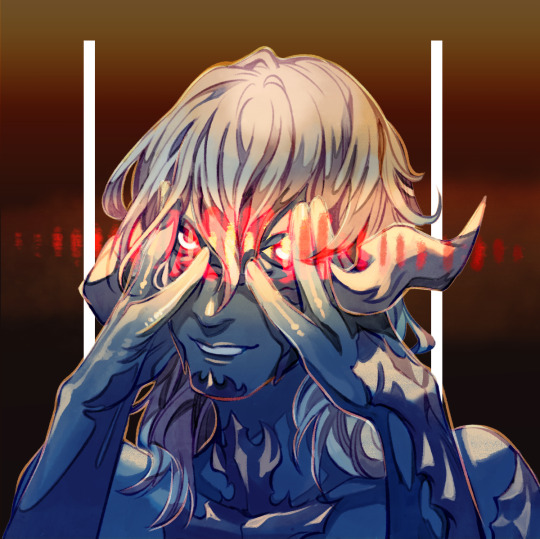
"Gender expressed in the UnObservable"
#telios#ffxiv#wol#oc art#original art#quantum physics???#quantum physics#double slit experiment#PLEASE LOOK UP THE DOUBLE SLIT EXP#im going bananas
105 notes
·
View notes
Text


A collection of wearable 3D art inspired by science:
✦ NEW: Wave-Particle Duality Pendant
✦ The Wave-Particle Duality Rings
✦ A Candle in the Dark: Lantern Earrings
Available now on Shapeways!
✦ Shapeways.com/shops/nature-in-theory
✦ Linktr.ee/NatureInTheory
Original designs © Olena Shmahalo / Nature in Theory
#3D printed jewelry#3D jewelry#3D art#3D printed#natureintheory#olena shmahalo#portfolio#2023#wave-particle duality#double slit experiment#particle physics#quantum physics#steampunk#gaslamp fantasy#darkacademia#shapeways#shapeways jewelry#goth jewelry#nerd jewelry#science jewelry#physics jewelry#science illustrator#sff art#scifi art#fantasy art#3D#noai#human artist
188 notes
·
View notes
Link
In 1801, British scientist Thomas Young carried out a 'double slit' experiment that has gone down in physics history: By shining light through two slits in a material, he showed that light behaved like a wave, taking different paths simultaneously only to intefere in predictable ways once they recombine.
Since that pioneering moment, the experiment has been repeated to demonstrate electromagnetic radiation displays both wave-like and particle-like behaviors. To put it another way, light can act like marbles rolling down a slope and like ripples in a pond, depending on how they're measured.
It's not just photons that act this way, either. Scientists have used similar setups to show electrons, neutrons, and whole atoms behaving in the same fashion, establishing a core tenet of quantum physics as a theory based on probability.
Now scientists have recreated Young's experiment with a modern twist. Instead of a pair of slits separated in space, they used 'time slits' created by rapid adjustments in the reflectivity of a material, testing the ability for a wave of light to interfere with its own past and future.
"Our experiment reveals more about the fundamental nature of light while serving as a stepping stone to creating the ultimate materials that can minutely control light in both space and time," says physicist Riccardo Sapienza from Imperial College London in the UK.
242 notes
·
View notes
Text

23 notes
·
View notes
Text
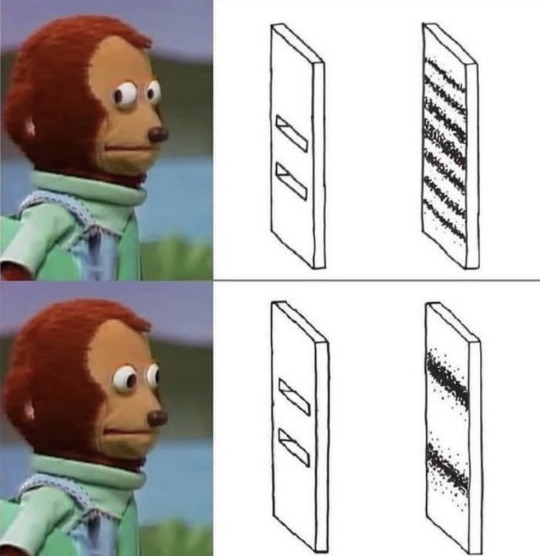
19 notes
·
View notes
Text

Somehow it knows when you’re watching.
9 notes
·
View notes
Text
Ramble about crazy physics, part one
So, once again. The double-slit experiment. Although, actually the many worlds interpretation, but I need both the double slit experiment and Schrödinger's famous cat to explain the whole thing.
You may already know these experiments, but I'll explain them anyway, just in case you don't. Also I'll probably split this ramble up in multiple posts, just so that one doesn't become to long.
Let's start with the double slit experiment, one of my favorites. It consists of an aperture with two parallel slits and a collecting screen. Small particles of material or a beam of light are sent through the two slits in order to obtain a so-called interference pattern at the collecting screen.
In the case of waves (light), an interference pattern is obtained that is somewhat irregular and looks like this:

This pattern is created because the wave splits at the slits and the newly created waves influence each other.
With particles (small material) you get an interference pattern that traces the two slits quite precisely and looks like this (shown as tennis balls, but it's the same principle):
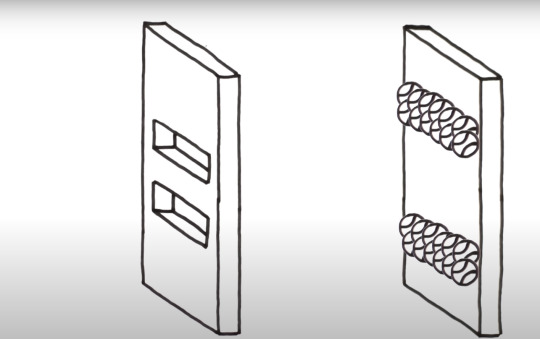
So far, so good.
Now we carry out this experiment with electrons, first with only one slit. We know that an electron is a particle, and that's exactly what the interference pattern we get looks like. So let's try it with two slits. What kind of interference pattern do we get?
That's right. The interference pattern of a wave-
Wait, what?
But that's exactly how it is. We get an interference pattern that looks pretty much like a wave.
Okay, maybe we did the experiment too fast and the electrons repelled each other. So we carry out the experiment more slowly, over hours, particle by particle. But the result is the same. We get the interference pattern of a wave. What is particularly confusing is that some places where the electron is on the collecting screen cannot be reached by a direct path through the slit, while other places that could be reached by a direct path remain free. Now we want to find out why this is the case. To do this, we attach a particle counter to the aperture to see which slit the individual electron flies through.
And obtain the interference pattern of a particle.
It almost seems as if the electron doesn't want us to understand it. Well, thanks, but we humans are not as stupid as we seem. We switch off the particle counter, but leave it in place. We'll see who's tricking who here -
- and we get the interference pattern of a wave again.
Well. Too bad.
How can it be that the interference pattern changes as soon as we try to fathom it?
Scientists are still unable to answer this question, but there is a well-known theory on the subject that is held by many scientists.
The Koppenhagen interpretation.
This states that the electron is in a so-called superposition until it is forced to make a decision by observation.
This means that the electron is on all possible paths until it is observed.
And if you plot all possible paths, what do you get? Exactly.
A wave. *Brain explosion.* (Weeeeeeeeeeeeee... Bam Kabush Crash Boom Whoosh)
So, like a wave, when the electron hits the two slits, the possible paths (my brain is dying right now) interfere with each other, creating an interference pattern piece by piece as soon as they are forced by the collecting screen to choose a possible path.
But why does this change as soon as we attach a particle counter?
Well. When the electron hits the particle counter, we already force the electron to choose a slit at this point to fly through either the upper or the lower slit. This means that if the electron decides to go through the upper slit, for example, the only possible paths left are the ones of the upper slit, which can no longer interfere with the possible lower paths → no wave interference pattern.
And this experiment is no joke so ingenious and mind-blowing that I can't even put it into words. How do you come up with something like this? How can it be that our observation can influence the result of an experiment, a reaction or ANYTHING in general? It may seem small now, but it just seems as if the world doesn't want us to understand it. Or at least the part of the world that includes quantum mechanics. How many times has it happened that our observation has influenced a result without us realizing it? How can we carry out experiments at all if our observation falsifies the result? Is this perhaps the reason why so many things should actually work in theory, but in practice it works quite differently? I don't believe that the electron is an isolated case - but how are we supposed to prove it? Through an experiment? Well, good luck with that.
@queenie-blackthorn
I have both the information and the pictures from two German videos, links here and here.
#rant#are you happy now#queenie?#crazy physics#physics#koppenhagen interpretation#double slit experiment#mindblowing#first of three rants#probably#the next rants will take wayyy more time#so don't expect me to drop them in like two days or so
5 notes
·
View notes
Text
i've decided that it's very important actually to not clean the tea things (mug, infuser, spoon, wherever you put the infuser down). when you attempt to clean the tea things, you permit yourself to become aware of their filth. before you embark on the accursed process of cleaning the tea things, they aren't clean, but they are also not truly dirty. their level of corruption is unassessed. it is only by the cleaning that they become dirty.
2 notes
·
View notes
Text
youtube
I posted before the 1/3/24 drawing that the Powerball number would be less that 10 based on data I had created. Since last night was a rare event, is there more at play here???
0 notes
Text
youtube
In this message Archangel Gabriel explains the nature of all existence as a spectrum of light, energy, and consciousness that comprises all that is, was, or ever can be. Buckle up for an in-depth look at the nature of existence itself.
For more information on the double-slit experiment mentioned in this video please watch this video from PBS Space Time: https://www.youtube.com/watch?v=p-MNSLsjjdo
Channeled by Daniel Zafer-Joyce on 11-8-22 at Strawberry Beach north of Santa Cruz, CA
If you would like to schedule your own private channeling for guidance you can do so at this link:
https://bit.ly/41ufEGA
If you would like to contact Daniel directly with questions you can use the contact link at universoulreiki.com
Follow on Instagram at @Universoul_Reiki for early glimpses of upcoming messages.
Music: A Day By The Sea Without Her by Spheriá | https://soundcloud.com/spheriamusic
Music promoted by https://www.chosic.com/free-music/all/
Creative Commons CC BY-SA 3.0
https://creativecommons.org/licenses/by-sa/3.0/
#double slit experiment#archangel gabriel#gabriel#angel#angels#channeled message#spirituality#faith#christianity#philosophy#theology#morality#channeling#religion#new age#Youtube
0 notes
Text
Wave-Particle Duality and the Dragon
A PHYSICS PRIMER AND A THOUGHT EXPERIMENT by John Alipio
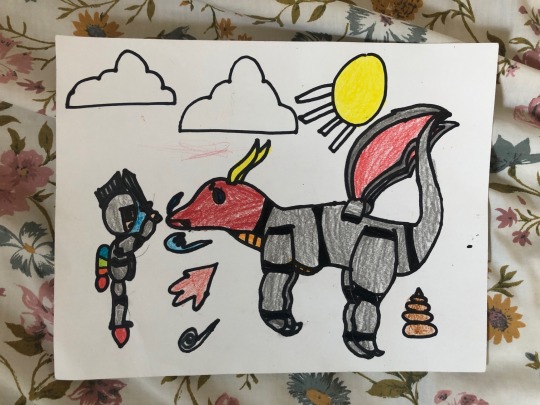
-Artwork by Oliver A.
The Double Slit Experiment
A fundamental mystery of quantum mechanics is wave-particle duality.
Waves and particles have very different properties. Multiple waves can exist in the same place at the same time, and they interfere with each other, meaning they cancel and amplify each other (e.g., sound and water waves). Particles, on the other hand, cannot be in the same place at the same time, and the energy of multiple particles is the sum of their individual energies (e.g., a baseball).
A wave-particle behaves as a wave in some circumstances and as a particle in other circumstances. It has both a wave nature and a particle nature. Light and the electron, which we will talk about further, are examples of wave-particles.
Thomas Young’s famous double split experiment is one way to demonstrate the wave-particle nature of light. To summarize, in this experiment, light is projected at a barrier which has two narrow slits. A screen is set up beyond the barrier to absorb the light after it passes through the slits. With a laser and some precise materials, this experiment can be easily replicated in a classroom.

The light passes through both slits, and the resulting waves overlap with each other and interfere. That is, they amplify or cancel each other to create an interference pattern. Because they are identical waves in wavelength and frequency, they create a pattern like this on the screen.

This interference pattern is proof that light behaves as a wave.
However, when the light hits the screen, it behaves as a particle. The light gets absorbed by the screen as individual packets of energy we call photons. The energy of the photons add up as we would expect energy of particles.
Although much trickier to pull off, the double slit experiment for electrons works similarly. Individual electrons are fired through the double slits. At first, the pattern that the electrons create on the screen seems random, but as more electrons are fired, a clear interference pattern emerges, which would be indication that the electron is interfering with itself as if it moved through both slits as a wave.
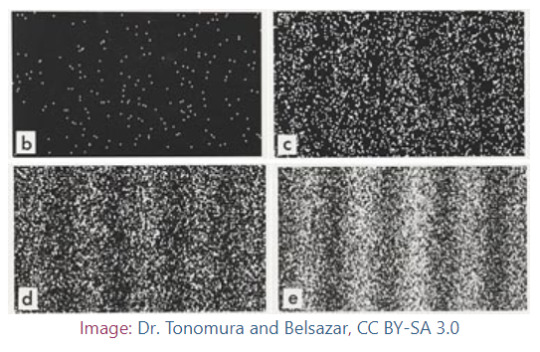
At the quantum level, the only way physics is able to describe and predict behavior is with mathematical probabilities. This means, when thinking about the electron, we have to allow for different possibilities to exist at the same time.
From a mathematical standpoint, there is a 50/50 probability that the electron will go through one slit or the other. The uncertain electron does not have to go through one slit or the other, so it is presumed to go through both slits (behaving like a wave).
Now introduce a detector which can record which slit the electron goes through. As soon as it records that information, the electron no longer has the “choice” of going through either slit or both slits. It must obey the laws of probability. The electron can only go through one slit. The pattern seems random again at the start, but as more electrons are fired, the pattern it creates is different. Instead of the wavy interference pattern we saw before, we see a pattern of two stripes, as if there was no interference with itself (behaving like a particle). This works the same with photons of light.

Marcus de Brun (https://physics.stackexchange.com/users/179575/marcus-de-brun), Double Slit Experiment. What effect does the detector actually cause? (https://physics.stackexchange.com/q/376494)
Light (and all other electromagnetic radiation) and electrons (and all other quantum objects) have wave-particle duality. Sometimes they behave as waves, sometimes they behave as particles. It depends on the circumstances in which they are detected.
The Dragon
You stand before a closed door, behind which there is a dragon. As the old maps depict, the dragon represents the unknown, the edges of our understanding.
No one knows for sure if the dragon exists or its shape, but the news of the dragon spreads through word of mouth, written word, movie, song. The thought of the dragon takes on a different shape for each person. Each has their own response— fear, curiosity, indifference, boldness. Their responses are individual, but as they interact with one another, their responses are magnified or diminished.
The dragon, for the time being, remains unconfirmed, but its impact is real. Like a wave, it rumbles through the community.
Suddenly everything changes, for you open the door and walk through. All the possibilities converge into one truth. The dragon will eat you, or it won’t.
The truth transforms you in a much more permanent way than the dragon behind the door. The truth leaves a mark.
Thanks for reading. Love,
John

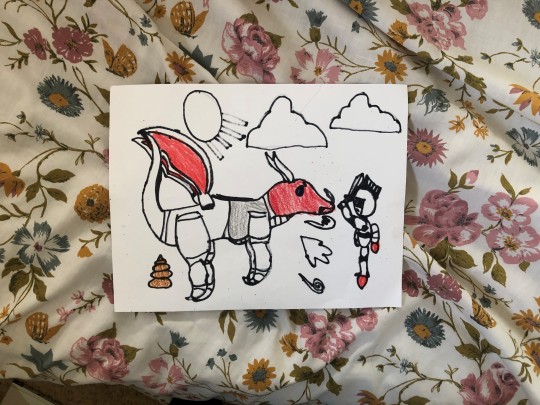
0 notes
Text

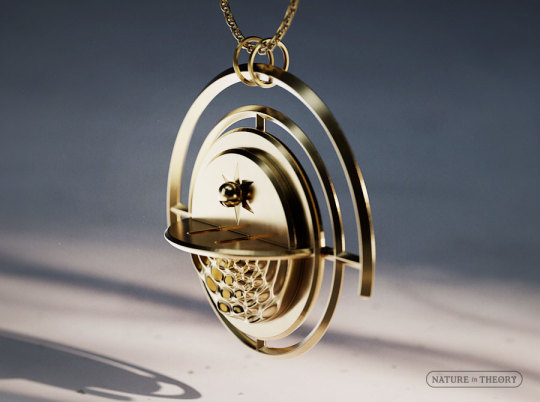

New particle physics jewelry:
The Wave-Particle Duality Pendant
More pictures of the whole collection in this post, and here:
✦ OlenaShmahalo.com/project/objects
✦ Shapeways.com/shops/nature-in-theory
#3D printed jewelry#3D jewelry#3D art#3D printed#natureintheory#olena shmahalo#portfolio#2023#wave-particle duality#double slit experiment#particle physics#quantum physics#steampunk#gaslamp fantasy#darkacademia#shapeways#shapeways jewelry#goth jewelry#nerd jewelry#science jewelry#physics jewelry#science illustrator#sff art#scifi art#fantasy art#3D#noai#human artist
41 notes
·
View notes
Text
Found out about the double slit experiment on space and now they're doing it to time and idk I'm excited about it rn
0 notes
Text
Chapter 6: Multiple-Slit Diffraction
6.1 Introduction
Multiple-slit diffraction occurs when light passes through an array of narrow, equally spaced slits, creating an interference pattern of bright and dark regions. In this chapter, we will discuss the basics of multiple-slit diffraction and explore the underlying principles that govern the formation of the resulting patterns.
6.2 Double-Slit Diffraction
Double-slit diffraction…
View On WordPress
0 notes
Video
youtube
Learning with Theta

1 note
·
View note
Text
Reality? What's that?
#double slit experiment#brian greene#physics#quantum mechanics#double slit#it's a wave#it's a particle#it's both
0 notes